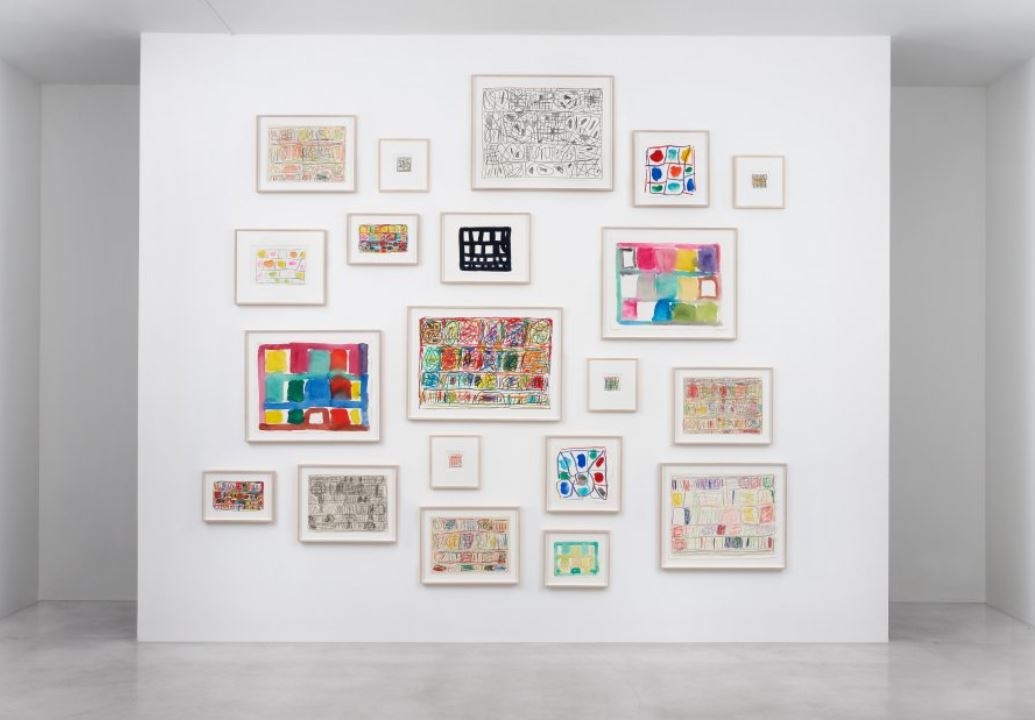Drawing has always played an integral role in Stanley Whitney’s practice. He says it keeps him in shape. While Whitney has removed gesture for the most part from his oil on canvas works, he uses the smaller scale of paper to explore a wider range of forms – “Drawing kind of keeps you young as a painter. Drawing keeps you dealing with a lot of possibilities. It keeps you fresh” (in conversation with Will Whitney, 2020).
Recently Whitney’s works on paper took on a more explicitly political character. In 2020 he made a suite of drawings in the wake of George Floyd’s death and in response to the ongoing discussions on mass incarceration in USA. The drawing Always Running from Police was printed in New York Magazine for an article on the authoritarian tactics of the Trump administration and in September of the same year Artforum published a suite of Whitney’s works on paper titled No To Prison Life as a portfolio in the magazine and the front cover.
The exhibition in Stockholm includes graphite, crayon, watercolour, gouache and their combinations on various types of paper. The paper’s characteristics are Whitney’s starting point. Semi-translucent ultra-light Japanese rice paper, handmade Lessebo rag paper, fine drawing paper, a piece of brown cardboard – each calls for its own approach and tool. The particularities of the materials bring touch, weight, gesture, mark and line to the fore.
Throughout the works Whitney fills his characteristic loose grids with line drawing and painted blocks, from monochromes to cacophonies of colour, and everything in between. Some buzz with intensity, live wires jolting over the surface, others stand solid like primordial structures. The graphite works are filled with knotted serpentine squiggles and in their visual depth, appear to occupy space below the surface of the paper. Some are furiously intense, while others meander across the page like cursive script or a calligraphic diagram. The gouaches are full-frontal seeping blocks of saturated pigment butting up and shouldering in on one another, like a class photo of motley individuals. Some are tonally harmonious with hues of blues, greens and greys for instance. Others pop and jostle in raucous discord.
Stanley Whitney was born in Philadelphia in 1946 and lives and works in New York City and Solignano, Italy. Whitney’s first retrospective is being planned at the Buffalo AKG Art Museum for 2023. Select solo exhibitions include Focus – Stanley Whitney at the Modern Art Museum, Fort Worth, TX, USA (2017) and Dance the Orange at the Studio Museum in Harlem, New York, NY, USA (2015). Whitney has also been included in many prominent group shows, such as Inherent Structure, Wexner Center for the Arts, Columbus, OH, USA (2018); Documenta 14 in Athens, Greece and Kassel, Germany (2017); Nero su Bianco at the American Academy in Rome, Italy (2015); Outside the Lines: Black in the Abstract, Contemporary Art Museum of Houston, TX, USA (2014); Reinventing Abstraction: New York Painting in the 1980s, Cheim & Read, New York, NY, USA (2013); and Utopia Station at the 50th Venice Biennale (2003). Last year Whitney was commissioned to make a suite of stained glass windows for the new Ruth R. Marder Center for Matisse Studies at the Baltimore Museum of Art. He has won prizes including the Robert De Niro Sr. Prize in Painting (2011), the American Academy of Arts and Letters Art Award (2010) and awarded a Guggenheim Fellowship (1996). Whitney’s work is included in public collections around the world, including Moderna Museet, Stockholm, Sweden, the Nelson-Atkins Museum of Art, Kansas City, KA, USA; the Philadelphia Museum of Art, PA, USA; the Solomon R. Guggenheim Museum, New York; and Yale University Art Gallery, New Haven, CT, USA. Whitney holds a BFA from Kansas City Art Institute as well as an MFA from Yale University and is currently Professor emeritus of painting and drawing at Tyler School of Art, Temple University.




